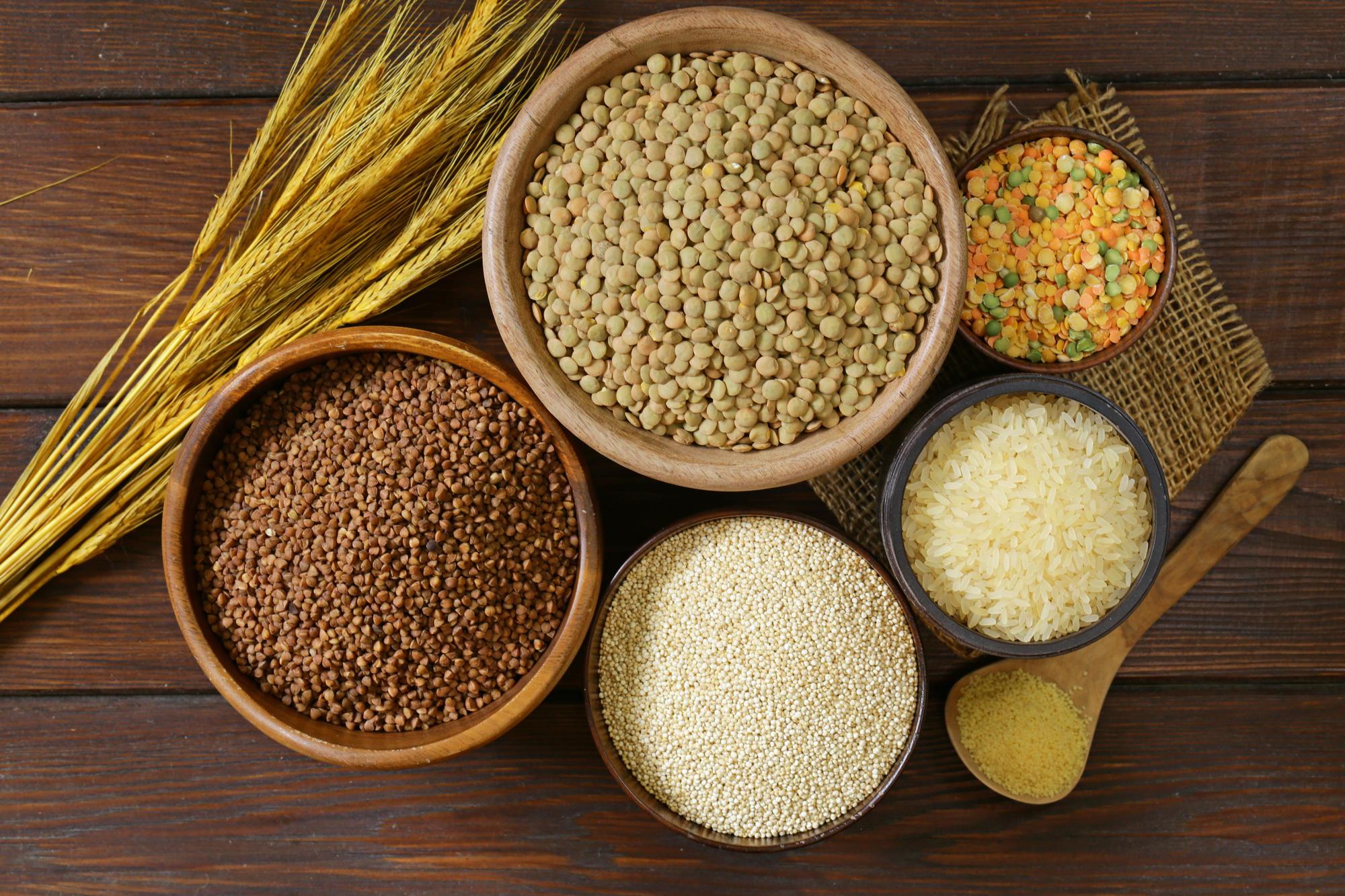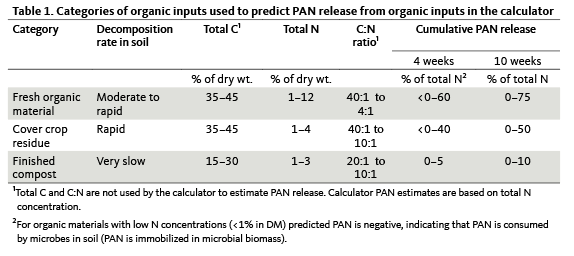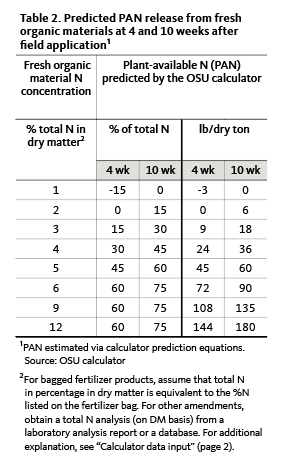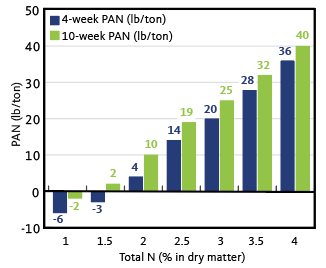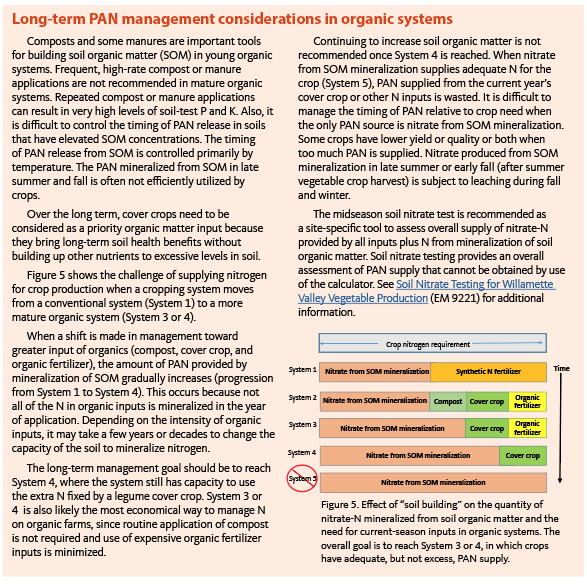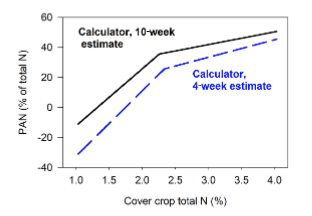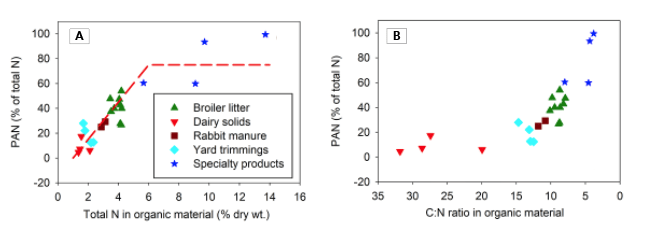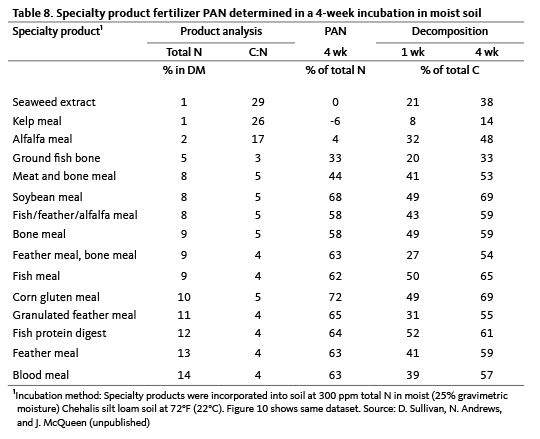The OSU Organic Fertilizer and Cover Crop Calculator is a tool to assist with preplant nitrogen (N) input decisions. It forecasts the quantity of plant-available nitrogen (PAN) provided by inputs such as fresh organic materials, cover crop residues, and finished compost. The calculator is an Excel-based worksheet available for free download via the OSU Small Farms Program website.
Why use the OSU calculator?
Organic fertilizers are complicated. Plants cannot use organic N directly. Organic fertilizers release an unknown quantity of “active ingredient” (PAN) after application to soil. The activity of soil organisms transforms organic N fertilizers into PAN through a process called mineralization. Mineralization converts organic N to plant-available forms (ammonium and nitrate-N).
The calculator predicts how much of the total N present in an organic material will transform to PAN during the first growing season after application in the field. By using the calculator, you can apply an appropriate amount of PAN for your crops, which will save money and protect groundwater from nitrate contamination. With the calculator, you can compare the cost of PAN from different organic materials. The calculator takes only a few minutes to perform calculations that would be time consuming and prone to error if done by hand.
Calculator data input
To use the calculator, you need to specify these organic input characteristics:
- Category of organic input—fresh organic material, cover crop residue, or finished compost.
- Percentage of dry matter (DM) in the fresh, “as-is” organic material.
- Total N analysis (% of N in dry matter).
- Application rate in the field (chosen by user).
To obtain this input data:
- See “Matching calculator PAN to crop N requirements” for crop PAN input requirements.
- Refer to the fertilizer label or ask suppliers of bulk organic materials to provide an analysis for dry matter and percent total N. A guaranteed total N analysis is required for products registered with the Oregon Department of Agriculture (see: this page from ODA). Assume that dry matter in bagged products is 90% to 100%.
- Send a sample of a specific organic material to an analytical laboratory, and request an analysis for total N and dry matter percentage. See Analytical Laboratories Serving Oregon (EM 8677) for additional guidance.
If the above information is not available, then use the following resources to approximate the necessary input data:
- Fertilizing with Manure and Other Organic Amendments (PNW 533) provides “book values” for typical total N analysis and dry matter percentage for uncomposted manures, and a worksheet for manure spreader calibration to determine application rate.
- Estimating Plant-Available Nitrogen Release from Cover Crops (PNW 636) illustrates several methods for measuring or estimating above-ground cover crop biomass, its dry matter percentage, and the total N percentage present in dry matter.
Categories of organic inputs
The calculator organizes organic inputs into three categories: fresh organic materials, cover crop residue, and finished compost. It predicts PAN at 4 and 10 weeks after application for each category of organic input. PAN predictions are based on the total N concentration present in dry matter.
Table 1 shows that the percentage of N present in organic materials can vary over a large range (1% to 12%), while the percentage of carbon (C) varies over a much more limited range, especially for fresh organic materials or cover crop residues.
The calculator uses the N concentration on a dry weight basis in an organic material as the input for all PAN prediction equations. Carbon to nitrogen ratio (C:N) is not used in the calculator’s prediction equations. We show the C:N ratio in Table 1 because many other publications discuss PAN in terms of C:N ratio.
Fresh organic materials and cover crop residues decompose rapidly in soil. Fresh organic materials provide a little or a lot of PAN, depending on the percentage of N they contain. Uncomposted animal manures and specialty fertilizers from fish, feather, blood, and seed meals are considered fresh organic materials.
Finished composts result from a controlled decomposition process that includes the addition of water. Finished composts are usually actively managed for 60 to 90 days. Once finished, composts decompose slowly and release PAN slowly. Calculator predictions of PAN release from composts are less than 10% of total N.
Organic materials that are stacked and allowed to self-heat without active management are not finished composts. A pile of organic matter that is not regularly watered will have an interrupted, incomplete decomposition. Manures that are more fresh than composted usually smell like ammonia; finished compost does not. Most organic fertilizers derived from chicken manure (pelleted or “composted”) release PAN at rates expected for fresh organic materials.
In reality, organic inputs do not always fit neatly into the three categories noted in Table 1. Ultimately, you must decide whether an organic material you work with is “fresh” or “finished compost.”
Calculator assumptions
The calculator assumes that:
- The C concentration of fresh organic materials is relatively constant (near 40%) and the percentage of total N concentration varies widely (from approximately 1% to 12%). Therefore, it is reasonable to use the N concentration rather than C:N as the predictor of PAN in the soil.
- Sufficient soil moisture or irrigation is present to support the mineralization process.
- Soil temperatures are warm enough to support the mineralization process.
- After mineralization, PAN is retained as nitrate-N in the soil.
Caveats
The calculator assumes that PAN loss from the soil is minimal under conditions present in summer vegetable crop production systems in the Willamette Valley of Oregon. In typical Willamette Valley cropping systems, organic inputs are incorporated by tillage, summer precipitation is minimal, and adequate but not excessive irrigation is supplied to meet crop requirements.
The calculator does not adjust PAN predictions based on soil temperature. See sidebar “Temperature effects on PAN” for explanation.
The OSU calculator does not forecast long-term PAN via mineralization from organic amendments. The calculator estimates PAN only during the first 10 weeks after the application of organic amendments. After the application year, only rough estimates of PAN release are possible. Research shows that approximately 5% to 10% of the total N provided by an organic input is converted to PAN during the second year after application.
The calculator is a tool for making preplant N input decisions. The calculator and this guide are not a substitute for monitoring the supply of soil nitrate-N during the growing season. We always recommend in-season soil nitrate testing because it evaluates all sources of PAN, including the N mineralized from soil organic matter. A companion publication, Soil Nitrate Testing for Willamette Valley Vegetable Production (EM 9221), describes how to sample soil and interpret the soil nitrate test results.
This publication does not provide cost comparisons among PAN sources. Use the OSU online calculator to compare the cost of PAN and other nutrients provided by different organic materials.
Calculator predictions of PAN from organic materials
This section shows calculator inputs and outputs for:
- Fresh organic materials
- Cover crop residues
- Composts
PAN predictions in the online calculator are listed in units of “% of total N” on a dry weight basis, and in units of “lb PAN/100 lb product” on a fresh weight or as-is basis. This publication lists PAN predictions only on a dry weight basis, using two units:
- percent of total N
- lb PAN per dry ton
The Appendix discusses the research that supports the PAN prediction equations in the calculator.
PAN from fresh organic materials
Fresh organic materials include animal manures that have not been composted and specialty fertilizers from fish, feather, blood, and seed meals.
PAN predictions for fresh organic materials are given in two units: percent of total N and lb/dry ton (Table 2). Figure 1 illustrates the PAN predictions (lb/dry ton). Note: See Appendix–1 for research data that supports calculator predictions for PAN from fresh organic materials.
PAN from cover crop residues
PAN predictions are given in two units:
- percent of total N (Table 3)
- lb PAN per dry ton (Table 3 and Figure 2)
Note: See the Appendix for research data that supports calculator predictions for PAN from cover crops.
PAN from finished compost
A controlled decomposition process, where compost remains moist during composting and curing, results in finished composts. About 60 to 90 days of active management are required to produce finished compost.
PAN predictions for composts are given in two units: percent of total N and lb/dry ton (Table 4). Figure 3 illustrates the PAN predictions (lb/dry ton). The range of PAN predicted from different composts is small (from 0% to 10% of total N). Research shows a weak relationship between total N concentration in compost and PAN provided by compost (Hartz et al., 2000; Gale et al., 2006; Prasad, 2009), so only a rough estimate of PAN is justified.
A few high N composts contain more than 2% total N and supply more PAN than is forecast in Table 4. Examples include some composted animal manures (without bedding) or compost derived from green, leafy crop residues (for example, peppermint). When compost total N is greater than 2% and an improved PAN estimate is desired, additional compost analyses (C:N, ammonium-N, nitrate-N) can be useful. See Interpreting Compost Analyses (EM 9217) for additional information.
Although PAN from compost is a small percentage of total N, it is still important to consider PAN from compost when it is applied at high rates for improving soil tilth. An inch of compost spread on an acre is equivalent to an application of approximately 30 to 40 dry ton per acre. An inch of a compost containing 2% total N (dry weight basis) supplies approximately 120 to 160 lb PAN/acre during the first 10 weeks after application.
Matching calculator PAN to crop N requirements
The calculator assumes that you have a target value in mind for crop N need (lb PAN required per acre). This section will help you estimate N input requirements for vegetable crops.
Table 6 provides general guidance for crops grown in fields undergoing organic transition or in established organic fields that have received organic inputs for many years. Generally, fields transitioning from conventional to organic management require greater PAN inputs than fields that have been managed organically for many years.
Vegetable crops require less N input when grown in midsummer than at other times of the year because of increased supply of PAN provided via decomposition of soil organic matter. For example, lettuce requires less PAN input in summer (June to August) than it does in spring (April to May).
Questions and answers
The calculator is a screening tool for estimating the timing and amount of PAN released from organic inputs during the first growing season after application. Some common questions that arise include: calculator predictions versus reality, nutrient management decisions, rate of N release from organic inputs, and making economic decisions with the calculator.
Calculator predictions versus reality
- Does the calculator take into account PAN release from soil organic matter or are the numbers based on PAN release from inputs alone?
The calculator predicts only PAN from current season inputs. It does not predict PAN mineralized from further decomposition of preexisting soil organic matter. This is the same approach used in OSU nutrient management guides. OSU nutrient management guides provide estimates of PAN input requirements based on field trials where the optimum PAN input rate was determined experimentally.
- How accurate are the PAN predictions in the calculator? Can I rely on them?
Field data from Willamette Valley cropping systems (western Oregon) support the calculator’s predictions for PAN from organic inputs. See the Appendix.
- Are calculator estimates of PAN from cover crops applicable to other regions and other cropping systems?
Research to support our recommendations was performed in the Willamette Valley, Oregon, where cover crops are normally seeded in fall and killed in spring prior to a summer vegetable crop.
We expect a strong relationship between cover crop %N and PAN to be found in most locations. However, the timing of PAN release will differ in regions outside of western Washington and Oregon. Our cover crop PAN predictions are in general agreement with a recent PAN model developed by the University of Georgia (Gaskin et al., 2019).
- I don’t have time to collect cover crop data for all of my fields. What do you suggest?
Cover crop species, coverage, and growth stage affect biomass. If you can’t measure it, use typical values from previous years at about the same growth stage. We recommend that you measure biomass (via sampling) and submit cover crop samples for total N analysis regularly as a way to check your estimates. See Estimating Plant-Available Nitrogen Release from Cover Crops (PNW 636) for cover crop sampling and testing instructions.
In our experience, biomass for a winter cover crop in the Willamette Valley in mid- to late April (a few weeks ahead of reproductive growth stage) is 3,000 lb to 5,000 lb DM/acre, with 2% to 3% total N in dry matter.
Nutrient management decisions
- I want to apply 100 lb PAN for my crop. Can I use the calculator to estimate the quantities of different nutrient sources I would need to fulfill that?
Use the “Nutrients Provided” tab in the calculator. Choose different input application rates for each organic input until you get a PAN estimate of 100 lb N/acre.
- I’ve been using chicken manure to provide N, and my soil-test P values are in the “excess” range. What should I do to avoid adding more P?
Cover crops don’t add P to the soil. Whenever feasible, grow a legume cover crop instead of using chicken manure or other manure-based fertilizer. If you do use an organic fertilizer, choose one that is low in P, such as feather meal or blood meal. Generally, fertilizers derived from plant materials are lower in P than those derived from animal manure or from fish.
- My field is high in soil organic matter (>5 %). Can I reduce N inputs?
The calculator does not make predictions for PAN mineralized from soil organic matter. Crops grown on soil with 5% soil organic matter often require lower N inputs compared to soils with 2% soil organic matter, but it is difficult to make quantitative predictions.
Instead of a prediction for PAN based on soil organic matter percentage, we recommend using in-season soil testing to determine whether N supplied by your fertilizer program and cropping practices is sufficient or excessive. See Soil Nitrate Testing for Willamette Valley Vegetable Production (EM 9221) for more details.
- If I fertilize my cover crop, will that change the PAN predictions in the calculator?
Fertilization often increases cover crop biomass and N concentration in biomass at a given stage of crop development, thereby increasing PAN released in soil after cover crop kill. Fertilizing cover crops that are planted to scavenge residual soil nitrate after harvest of the summer crop (for example, squash, corn, tomato) is not recommended.
Rate of N release from organic inputs
- I use fish or feather meal or pelleted chicken manure to supply N for overwintering vegetable crops. I apply fertilizer in February when soil temperatures are cold. Are calculator PAN predictions for an early spring application reliable?
You can use the calculator to guide specialty product application when soils are cold. The release of nitrate by mineralization of these products occurs more rapidly than crop uptake of N, even in cold soils. See “Temperature effects on PAN” for additional explanation.
- Are cover crops an important source of slow-release nitrogen?
Data collected to support the calculator PAN estimates show that most of the PAN release from cover crops occurs within the first 4 weeks after soil incorporation. The quantity of PAN released during the first 4 weeks at 72°F (22°C) ranges from -6 to 36 lb per ton of dry matter incorporated (Table 3). Between 4 and 10 weeks, additional PAN release is 4 to 6 lb/ton. After 10 weeks, the release of PAN from any soil-incorporated cover crop is negligible and can be ignored when making N management decisions.
- Does the method used to kill a cover crop affect PAN?
Local research has not addressed whether the method used to kill a cover crop (tillage, herbicide, roller-crimper, mowing) affects PAN. Research from other regions suggests that the cover crop kill method does not affect the amount of PAN released during the year following the cover crop. Compared to incorporation of crop residue, we would expect PAN release to be slower when cover crop residues remain on the soil surface, especially where surface moisture is limited.
- How much PAN is produced by decomposition of cover crop roots?
Cover crop roots contribute only a small amount of PAN for the following crop and are ignored in calculations used in this publication. Research conducted in western Washington showed that Austrian pea and hairy vetch cover crops contained approximately 100 lb N/acre above ground, but only 10 lb N/acre in roots (Kuo et al., 1997). Roots also had a low N concentration in dry matter (% N less than 2 percent; C:N ratio greater than 20), suggesting that PAN release would be near zero.
Using the calculator for economic decisions
- How do I find the least expensive fertilizer program with the calculator?
Enter the costs of the fertilizers you are comparing in the “Cost Comparisons” tab in the calculator. View the cost per pound of PAN, given product characteristics (price, total N analysis, and dry matter percentage). Try different options to find the least expensive alternative.
- How does the calculator estimate the value of PAN from cover crops?
The calculator includes a “Your Costs” worksheet to determine input costs ($/acre) to grow and kill a cover crop, including seed, labor, fuel, irrigation, and equipment depreciation. PAN from cover crop residue is then estimated (lb PAN/acre) based on equations that are discussed in this publication:
Cost per lb of PAN = $/acre ÷ PAN (lb/acre)
- Can I customize estimated costs for a cover crop in the calculator to fit my situation?
You can update costs for seed, tractor fuel, number of irrigations, and labor. You can enter current seed, fuel, and labor rates. Equipment costs for seeding and incorporating a cover crop are based on 2010 depreciation estimates. Irrigation costs to establish the cover crop are based on 2010 electricity rates.
Appendix: Calculator equations and supporting verification data
Calculator prediction equations
Equations A, B, and C reference “total N” and “PAN.” These terms correspond to the following values: :
- total N = total N analysis (% in dry matter) of fresh organic material, cover crop, or compost
- PAN = plant-available N (% of total N applied)
Equation A: PAN from fresh organic materials (includes manures and specialty products)
PAN is predicted by segmented equations, as shown in Figure 6. The “change point” between the two linear equations is 6% total N at both 4 and 10 weeks after application. Inputs and outputs for these equations are shown in Table 2 and Figure 6. In equation form:
- At 4 weeks after application
When total N is less than 6%:
PAN = −30 + (15 × total N)
When total N is more than 6%:
PAN = 60%
- At 10 weeks after application
When total N is less than 6%:
PAN = −15 + (15 × total N)
When total N is more than 6%:
PAN = 75%
Equation B: PAN from cover crops
PAN is predicted by segmented equations, as shown in Figure 7. The “change point” between the two linear equations is approximately 2.3% total N at both 4 and 10 weeks after application. Inputs and outputs for these equations are shown in Table 3 and Figure 7. In equation form:
- At 4 weeks after application
When total N is less than 2.34%:
PAN = −31 + [(total N−1.03) × 43.3]
When total N is more than 2.34%:
PAN = 25.8 + [(total N−2.34) × 11.7]
- At 10 weeks after application
When total N is less than 2.26%:
PAN = –11 + [(total N−1.03) × 37.9]
When total N is more than 2.26%:
PAN = 35.6 + [(total N−2.26) × 8.5]
Equation C: PAN from finished compost
PAN is predicted by tabular look-up values, based on the total N percentage in DM. See Table 4. In equation form:
- At 4 weeks after application
When total N is less than 1%: PAN = 0
When total N is 1 to 2%: PAN = 0
When total N is more than 2%: PAN = 5%
- At 10 weeks after application
When total N is less than 1%: PAN = 0
When total N is 1 to 2%: PAN = 5%
When total N is more than 2%: PAN = 10%
PAN from fresh organic materials and composts: field and laboratory trials
- Methods: PAN from fresh organic materials and composts—field trials
Field trials were conducted in Aurora, Oregon on a Willamette silt loam soil and in Puyallup, Washington on a Puyallup sandy loam soil (Gale et al., 2006). PAN was determined in field trials with sweet corn. Each field trial included plots on which no organic material was applied (soil-only control), plots receiving preplant application of fresh organic materials or compost, and plots receiving urea-N at rates of 0, 50, 100, 150, and 200 lb N/acre. Organic materials were applied on approximately May 1. Organic materials were incorporated by tillage on the day of application. Corn was seeded about 30 days later, and corn ears were harvested September 4 to 12. PAN release from organic materials was estimated using an N fertilizer equivalency method.
- Methods: PAN from fresh organic materials and composts—laboratory trials
Laboratory incubations of organic materials in moist soil were used to develop calculator PAN predictions (Gale et al., 2006). Subsamples of each organic material were ovendried to determine dry matter percentage and total N concentration. Fresh or frozen organic materials (for example, manure, specialty products, cover crop, and compost) were added to moist soil at the start of incubation (Figure 11). The organic materials that were incubated in soil to determine PAN were not oven-dried or finely ground. Previous research in our laboratory showed that incubating fresh or frozen organic materials in soil gave more realistic PAN estimates than using oven-dried, ground organic materials.
After incubation for 4 and 10 weeks, soil was analyzed for both forms of PAN (ammonium and nitrate-N). Because ammonium-N concentrations were always low after 4 weeks of incubation, only soil nitrate-N was used to estimate PAN.
Equation D: Experimental determination of PAN
In laboratory incubations, PAN released from organic inputs was determined experimentally by difference from a soil-only control treatment:
% PAN from organic input = [(Amended - Control) ÷ Input N] x 100 where:
Field measurements of PAN collected at the time of corn ear harvest (Table 7) were highly correlated with measurements of PAN at 10 weeks in the laboratory (Figure 8).
Segmented linear equations were a reasonable fit to the observed PAN data (Figure 9A).
Few composts were included in the field and laboratory trials (Gale et al., 2006). PAN estimates for compost in the calculator are primarily based on data (not shown) from other experiments.
PAN from specialty products
Specialty products are considered “fresh” organic materials in the calculator since they have not been stabilized by composting. We evaluated organic fertilizer products offered for sale to organic farmers in the north Willamette Valley, Oregon.
To determine PAN, we performed a 4-week laboratory incubation at 72°F (22°C). Specialty products included seed meals, fish byproducts, and animal byproducts. We also measured decomposition as a loss of C as carbon dioxide during the incubations.
Specialty products that contained 8% to 14% total N (in DM) released approximately 60% of total N as PAN after 4 weeks in soil (Table 8 and Figure 10). Measured PAN from specialty products was close to that predicted by the OSU calculator equation for fresh organic materials (Figure 10).
PAN from cover crop residues
PAN prediction equations for cover crop residues were developed from laboratory incubation experiments. PAN was also measured in selected field trials following plowdown of cover crop residues.
Cover crop biomass samples were harvested from field plots in April at vegetative growth stage or in May at early reproductive growth stage (Tables 9 and 10). Cover crop species included legumes (common vetch, clovers), cereal rye, and phacelia. Cover crop samples were refrigerated or stored in a freezer for less than 1 week prior to the start of incubations. Cover crop samples were not oven dried or ground prior to laboratory incubations to determine PAN.
On the day an incubation began, cover crop samples were cut into small pieces (less than half an inch long) with a knife, then added to moist soil (20% to 25% gravimetric moisture, Figure 11). Subsamples of cover crop biomass were collected at the start of the incubation for determination of dry matter and total N.
The soils used for the cover crop incubations varied with year. Soil textures included silt loam, loam, and sandy loam. Soils were collected in moist condition from the field, sieved to pass a 0.3 inch (8 mm) screen, and refrigerated until a week prior to the start of an incubation. Some soils were misted with a spray bottle prior to incubation to bring soil moisture to the target level (20% to 25% gravimetric moisture).
Cover crops were added to moist soils and incubated at 72°F (22°C) in a zippered plastic freezer bag. Cover crop dry matter was added at a rate of 0.5% to 1.0% of soil dry weight so that the cover crop total N addition rate was a minimum of 100 ppm (mg N/kg dry soil). Each incubation included a soil-only control (no cover crop added). After the addition of the cover crop, the bags were zippered closed. A drinking straw was inserted at the edge of the zipper in each bag to allow air entry. The bags were then placed in a large plastic tub that had a sheet of wet polyurethane foam on the bottom and a loose-fitting lid to allow air entry (Figure 11).
After 4 and 10 weeks of incubation at 72°F (22°C), soil from the incubation bags was subsampled and nitrate-N was determined. Cover crop PAN was determined by difference, by subtracting the nitrate-N present in the no-cover-crop control bags (Equation D).
A combined dataset from the three laboratory incubations was used in the development of the calculator equations to predict PAN from cover crop residues. In Experiments A and B, a wide range of cover crop total N (% in DM) was attained by mixing non-legume biomass (cereal rye, oat, or phacelia) with legume biomass (common vetch or clover) at specified DM ratios (for example, 25% legume, 75% non-legume as shown in Table 9). In Experiment C, mixed species cover crop samples for incubation were obtained from field plot harvest of cover crops (Table 10).
Segmented linear regression was used to develop prediction equations for cover crop PAN. This regression technique represents the relationship between cover crop N (% in DM) and PAN (% of total N) as two lines that come together at a change point where the slope of the regression line changes.
The regression equations shown in Figure 12 and also listed in “Calculator prediction equations: PAN from cover crops” were developed as a replacement for the cover crop prediction equation present in the original (2010) version of the calculator. The original calculator equation was adopted from PAN data for Kansas crop residues (Vigil and Kissel, 1991) with an unspecified time interval after crop residue incorporation for PAN prediction. Equations currently employed in the calculator (Equation B and Figure 7) provide 4- and 10-week PAN predictions.
The segmented PAN prediction equations have a change point at approximately 2.3% total N. When a cover crop N concentration is less than 2.3% total N, the PAN produced (% of total N) by mineralization is strongly related to cover crop total N concentration, as indicated by a steep slope to the PAN prediction line (Figure 12). When cover crop N concentration is above 2.3%, PAN (% of total N) is less sensitive to changes in cover crop N concentration (shallower slope to PAN prediction line). The change point in the calculator regression equations (2.3% N in DM) corresponds with a cover crop C:N ratio of 17.
As with any regression relationship developed from real data, the actual PAN reported for an individual cover crop sample was not exactly equal to the calculator PAN prediction. Figure 12 shows this variability. For example, when cover crop total N (% in DM) is 3.0%, predicted PAN is 42% for 10 weeks, but observed data ranges from 35% to 55% PAN.
Predicted PAN from cover crops was computed by the OSU calculator (Equation B) based on measurements of biomass and total N (% in DM) present at each field location (Table 10). Actual PAN was determined in the field by soil sampling for nitrate-N early in the summer vegetable crop growing season. Winter cover crops were incorporated in April, and soil nitrate was measured 6 to 7 weeks later, on approximately June 10. Soil was collected from fertilized and unfertilized cover crop treatments in each field, and the net increase in soil nitrate-N (cover crop treatment minus no cover crop treatment) was calculated. Values for PAN prediction by the calculator were converted to soil nitrate-N (0- to 12-inch depth) assuming a soil bulk density of 81 lb per cubic foot (1.3 g/cm³). Using this conversion factor, 35 lb PAN per acre = 10 ppm nitrate-N.
PAN measured at four on-farm, northern Willamette Valley field sites monitored in 2009 is shown in Figure 13 . Table 10 shows the cover crop kill dates and cover crop biomass present at the field sites. Actual PAN, measured by soil sampling at 6 to 7 weeks after cover crop incorporation, was equal to or slightly greater than PAN predicted by the calculator for 4 and 10 weeks (Figure 13). Actual PAN measured by soil testing was more variable than calculator PAN estimates. Across field locations, the actual net increase in PAN with cover crops ranged from 9 to 23 ppm (approximately 30 to 80 lb/acre), while PAN predicted by the calculator ranged from 9 to 14 ppm (30 to 50 lb/acre). Across the four field locations, the actual increase in PAN with cover crops averaged 15 ppm (50 lb/acre).
PAN for cover crop treatments in a replicated field trial conducted on a Chehalis soil at the OSU Lewis-Brown Farm is shown in Figure 14 (Luna et al., 2018). Winter cover crops were killed and incorporated at early flowering growth stage in May, 2007. Net soil nitrate-N from cover crops was measured at 10 weeks after cover crop incorporation using the same protocol described for experiment C.
Oat and phacelia immobilized N (negative PAN) while vetch alone or in vetch mixtures provided PAN. At 10 weeks, predicted PAN was near zero (1 ppm nitrate-N; 4 lb/acre) for non-legumes (phacelia and oat), while actual PAN at 10 weeks was -4 to -1 ppm (-14 to -4 lb/acre). At 10 weeks, predicted net PAN from vetch, oat/vetch, or phacelia/vetch mixtures was 10 to 14 ppm nitrate-N (35 to 49 lb N/acre), while actual PAN was 6 to 13 ppm (21 to 46 lb/acre).
© 2019 Oregon State University.
Extension work is a cooperative program of Oregon State University, the U.S. Department of Agriculture, and Oregon counties. Oregon State University Extension Service offers educational programs, activities, and materials without discrimination on the basis of race, color, national origin, religion, sex, gender identity (including gender expression), sexual orientation, disability, age, marital status, familial/parental status, income derived from a public assistance program, political beliefs, genetic information, veteran’s status, reprisal or retaliation for prior civil rights activity. (Not all prohibited bases apply to all programs.) Oregon State University Extension Service is an AA/EOE/Veterans/Disabled.
- % PAN = percentage of total input N that is recovered from soil as nitrate-N after incubation
- Amended = Soil nitrate-N with organic material added (ppm)
- Control = Soil nitrate-N without organic input (ppm)
- Input N = amount of total N added to soil via organic input (fresh organic material, compost, or cover crop residue; ppm)
- Results: PAN from fresh organic materials and composts—field and laboratory trials
- Methods: PAN from cover crop residues—laboratory incubation Experiments A and B
- Results: Laboratory incubation experiments A and B
- Methods: PAN from cover crops—field experiment C
- Results: PAN from cover crops— field experiment C
- Methods: PAN from cover crops—field experiment D
- Results: PAN from cover crops—field experiment D


